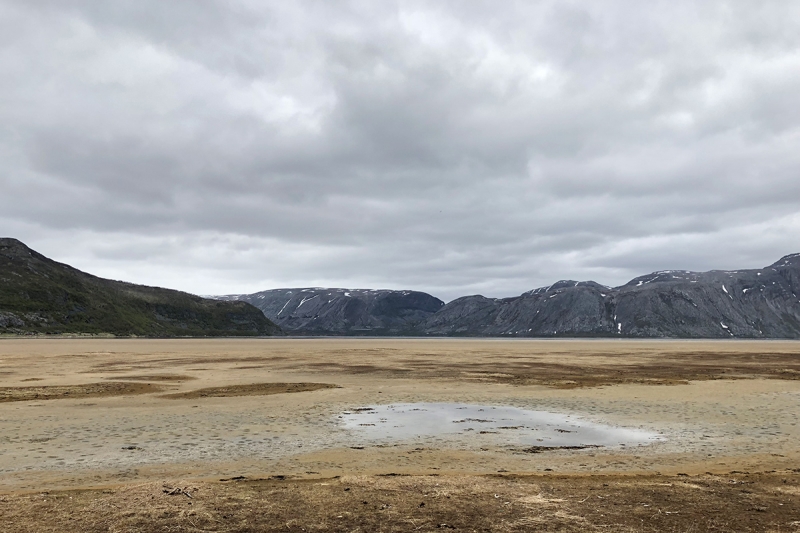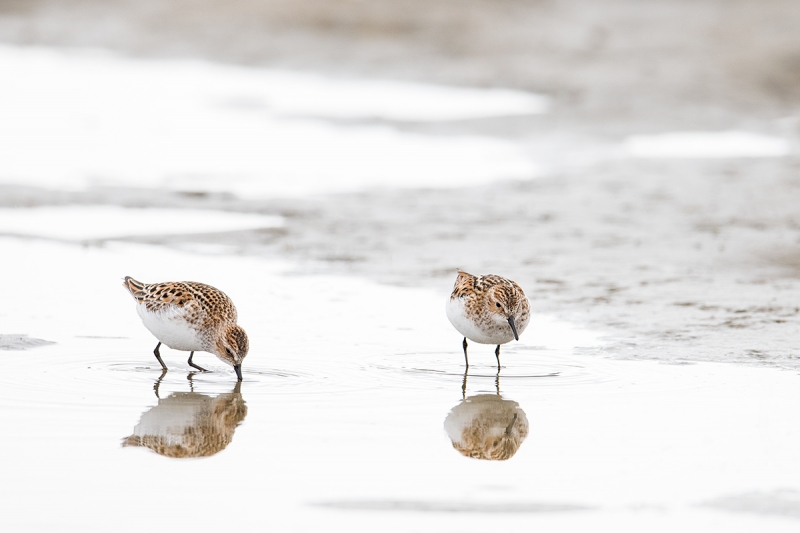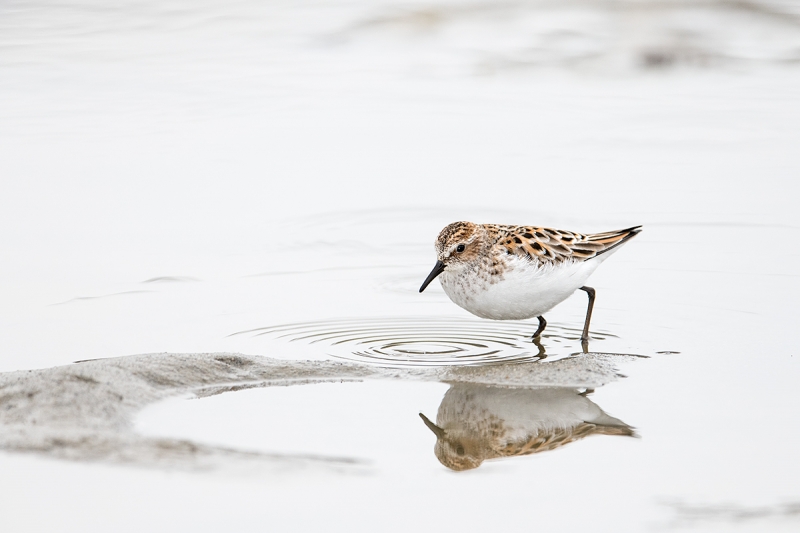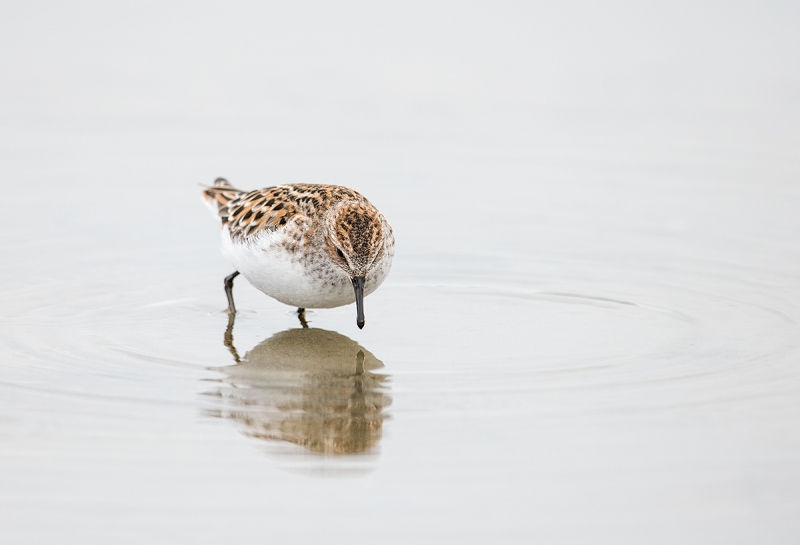Stuff
On Tuesday we took the boat from Vardo to Hornoya Island to photograph some of the 100,000+ seabirds. The cliffs are dominated by Common Guillemot (our Common Murre), Black-legged Kittiwakes, Atlantic Puffins, and Razorbills. A good percentage of the Common Guillemots are of the bridled form. There are also about 500 pairs of Brünnich’s Guillemot (our Thick-billed Murre if I am understanding correctly), but I did not know what to look for before doing the research for this Stuff 🙂 If we return, I will be on the lookout for Brünnich’s Guillemot.
In spite of the fact that the photography was exceedingly difficult, and that we were all under-dressed and nearly froze to death, we had a great time. Photos and the complete story soon 🙂
This Just In!
After editing my images from Hornoya — you will not believe my keeper rate for the day — I realized that my best murre flight image was a Brünnich’s Guillemot.
BIRDS AS ART
BIRDS AS ART is registered in the U.S. Patent and Trademark Office.
Selling Your Used Photo Gear Through BIRDS AS ART
Selling your used (or like-new) photo gear through the BAA Blog is a great idea. We charge only a 5% commission. One of the more popular used gear for sale sites charged a minimum of 20%. Plus assorted fees! Yikes. They went out of business. And e-Bay fees are now up to 13%. The minimum item price here is $500 (or less for a $25 fee). If you are interested please scroll down here or shoot us an e-mail with the words Items for Sale Info Request cut and pasted into the Subject line :). Stuff that is priced fairly — I offer pricing advice to those who agree to the terms — usually sells in no time flat. Over the past year, we have sold many dozens of items. Do know that prices on some items like the EOS-1D Mark IV, the old Canon 100-400, the old 500mm, the EOS-7D and 7D Mark II and the original 400mm DO lens have been dropping steadily. You can always see the current listings by clicking on the Used Photo Gear tab on the orange-yellow menu bar near the top of each blog post page.
Canon EOS 5D Mark III
Price Reduced!
Jim Keener is offering a Canon EOS 5D Mark III body in excellent condition for the BAA record-low price of $999.00 (was $1149.00). The sale includes the front body cap, the charger, the original battery, and insured ground shipping via to continental US addresses only. The package will not ship until your check clears.
Please contact Jim via e-mail or by phone at 310-741-7435 (9am-9pm Mountain time).Carl via e-mail.
I owned and used this superb, full frame, 22mp digital body for several years. It was always my first choice for scenic, Urbex (urban exploration), and flower photography until I fell in love for a while with the 5DS R (for a lot more money!). Then I switched to the 5D IV body. In addition, I loved my 5D III body for birds with my big lenses and both TCs. I used mine to create many dozens of high quality images. Then I switched to Nikon. Jim’s body can be yours for a bargain price. artie
Five D850s Available Right Now!
Contact Steve below to get yours.
Money Saving Reminder
If you need a hot photo item that is out of stock at B&H, would enjoy free overnight shipping, and would like a $50 discount on your first purchase, click here to order and enter the coupon code BIRDSASART at checkout. If you are looking to strike a deal on Canon or Nikon gear (including the big telephotos) or on a multiple item order, contact Steve Elkins via e-mail or on his cell at (479) 381-2592 (Eastern time) and be sure to mention your BIRDSASART coupon code and use it for your online order. Patrick Sparkman saved $350 on a recent purchase!


Booking.Com
Several folks on the DeSoto IPT used the Booking.Com link below, got great rates, and saved a handsome $25.00 in the process. If you too would like to give Booking.Com a shot, click here and to earn a $25 reward on your first booking. Thanks to the many who have already tried and used this great service.
Gear Questions and Advice
Too many folks attending BAA IPTs and dozens of photographers whom I see in the field and on BPN, are–out of ignorance–using the wrong gear especially when it comes to tripods and more especially, tripod heads… Please know that I am always glad to answer your gear questions via e-mail. Those questions might deal with systems, camera bodies, accessories, and/or lens choices and decisions.
|
|
|
This image was created with the hand held i-Phone 8+ (at 1X). Image #1: The Pool on the Delta |
The Situation
We were headed north to Gedjne (say GED-nuh, rhymes with Edna) when Anita North suggested we take the dirt road to the left; so we did. Hoyholem Road led down to the Tana River. On our right were extensive mud and sand flats, on our left, a large expanse of short-grass habitat. The only birds that we saw for the first kilometer or so were a few distant Common Gulls. When we passed the pool seen in the photo above, I said, “Jeez, there should be some shorebirds in that perfect little puddle. We pulled ahead about 100 meters to an even smaller pool and got out to take a look. When I glanced back to my right I saw two small sandpipers land in the pool.
We set up and walked back towards the birds stopping along the way to identify them: they were breeding plumage Little Stints; I was excited!
|
|
|
This image was created on June 10, 2018 at the Tana River Delta. I used the Induro GIT 304L/Mongoose M3.6-mounted Nikon AF-S NIKKOR 600mm f/4E FL ED VR lens with the Nikon AF-S Teleconverter TC-14E III and the Nikon D850. ISO 800. Matrix metering + 1 2/3 stops as originally framed: 1/640 sec. at f/6.3. NATURAL AUTO WB at 10:33am on a cloudy day. Center d-9/Continuous (AI Servo in Canon)/Shutter button AF was active at the moment of exposure. The selected AF point was on the bird on our right. The image above is a substantial crop from the original. Click on the image to see a larger version and you will see that the D850 image quality held up nicely. Focus peaking AF Fine-tune: +5. See the Nikon AF Fine-tune e-Guide here. Image #2: Little Stint, two feeding in shallow pool |
Little Stint
Little Stint is a small calidrid sandpiper. Before last Sunday, I had seen only one in my life, that at Jamaica Bay Wildlife Refuge in Queens, NY in 1983. It was New York State’s first. Little Stint is an extreme rarity in North America with occurrences on both coasts. At the time, there was not a lot of good ID information on separating Little Stint from Red-necked (Rufous-necked at the time, I believe) Stint. I think that the late Thomas H. Davis Jr., all 6′ 9″ and 145 pounds of him, found the bird and initially thought that it was a Rufous-necked Stint.
It was, however, expert birder and noted avian artist John Yrizarry who first identified that bird correctly after studying specimen skins at the American Museum of Natural History in New York. I was there when he met Tom and said in his Irish/Basque/Brooklyn accent, “Its a shtint alright, but it’s a Little Shtint!” John along with wife Mary led field trips mainly to Prospect Park in Brooklyn for several decades and inspired hundreds of folks to take up birding. They now live in Tuxedo Park, a village in Orange County, New York where they do lots of volunteer conservation work.
When Lars Jonsson’s article on stint identification was published in American Birds right around that time, the confusion on separating the two species in breeding plumage pretty much ended. Lars Jonsson is a skilled and gifted Swedish natural history artist and painter. You can learn more about Lars and see some of his beautiful work on his website here. On a personal note, Tom Davis had written Lars about stint IDs in the earlty 1980s. Lars kindly sent Tom some pencil sketches that illustrated the differences between the two species. After Tom’s premature death, probably in 1986 or 87, his parents contacted me and bequeathed Lar’s letter to me. (They knew of me because I had taken over the shorebird survey for then Manomet Bird Observatory when Tom was stricken by a cerebral aneuyism in the early 1980s; he became hemiplegic from that day on, completely paralyzed on his left side as I remember it. Tom, who was my shorebird mentor, had done the survey for several years in the late 1970s.)
In Image #2 you can see the creamy white v-shape on the bird on our right that is lacking in Red-necked Stint. More on the ID below.
|
|
|
This image was also created on June 10, 2018 at This image was created on June 10, 2018 at the Tana River Delta. I used the Induro GIT 304L/Mongoose M3.6-mounted Nikon AF-S NIKKOR 600mm f/4E FL ED VR lens with the Nikon AF-S Teleconverter TC-14E III and the Nikon D850. ISO 800. Matrix metering + 1 2/3 stops as originally framed: 1/800 sec. at f/6.3. NATURAL AUTO WB at 10:36am on a cloudy day. Center d-9/Continuous (AI Servo in Canon)/Shutter button AF was active at the moment of exposure. The selected AF point was on the bird on our right. The image above is a crop from the original. Click on the image to see a larger version and you will see that the D850 image quality held up nicely. Focus peaking AF Fine-tune: +5. See the Nikon AF Fine-tune e-Guide here. Image #2: Little Stint, breeding plumage |
More on the ID
Little Stint in breeding plumage has whitish chin and upper neck with a prominent whitish line over the eye. Red-necked Stint in breeding plumage has completely un-streaked orange chin and neck and only a very faint eyeline. In 1985, two years after the Little Stint, I found and identified New York State’s first Rufous-necked Stint in early July of 1985. Picking that bird out from 1500 much duller, molting adult Semipalmated Sandpipers was a huge thrill for me. Tom Davis was taken to the East Pond by stretcher to see the bird but had no luck on his first attempt. On his second attempt, he was successful. It was his last life bird.
In North America Little Stint might be confused with the very common Least Sandpiper (in some plumages). But Least Sandpiper has yellowish legs and a fine-tipped slightly decurved bill. Little Stint has black legs and when the bill is seen from above, the bill tip is slightly bulbous (as seen in Image #3).
Life Birds
A life bird is a bird that you see and identify for the first time ever. Thus, Little Stint was not a life bird for me. More on that topic soon 🙂
Shorebirds; Beautiful Beachcombers
To learn more about shorebirds pick up a copy of my Shorebirds; Beautiful Beachcombers. Written for naturalists and birders, the text tells you everything you’ve always wanted to know about North America’s sandpipers, godwits, yellowlegs, phalaropes, plovers, avocets, stilts, and oystercatchers. Topics covered include identification and aging, shorebird behavior, their incredible migrations, feeding and diet, mating and breeding strategies, eggs, nests, and young, conservation efforts, and shorebirding tips. Also included are approximately 50 species accounts covering all of the regularly occurring North American shorebird species. With 70 of Arthur’s images and 26 more by some of the world’s best nature photographers, this book contains the finest collection of shorebird photographs ever published in a single volume.
|
|
|
This image was also created on June 10, 2018 at the Tana River Delta. I used the Induro GIT 304L/Mongoose M3.6-mounted Nikon AF-S NIKKOR 600mm f/4E FL ED VR lens with the Nikon AF-S Teleconverter TC-14E III and the Nikon D850. ISO 800. Matrix metering + 1 1/3 stops as originally framed: 1/800 sec. at f/6.3. NATURAL AUTO WB at 10:38am on a cloudy day. Center d-9/Continuous (AI Servo in Canon)/Shutter button AF was active at the moment of exposure. The selected AF point was on the bird on our right. The image above is a crop from the original. Click on the image to see a larger version and you will see that the D850 image quality held up nicely. Focus peaking AF Fine-tune: +5. See the Nikon AF Fine-tune e-Guide here. Image #3: Little Stint, breeding plumage |
The Photographic Strategy
Note that Image #1 was taken as a record shot to confirm the ID. With both birds on the same plane it was a surprise that it turned out to be a useable image. Over the course of the next five or six minutes the three of us approached slowly and carefully getting a bit closer each time. Note that the three images presented here today will not win any prizes. In fact, there are surely hundreds of better images of more brightly colored breeding plumage Little Stint. But seeing an old friend for the first time in 35 years and creating a few decent images was a big thrill for me.
Your Favorite?
Which of today’s featured images is your favorite? Be sure to let us know why you made your choice.
Little Stint?
If you have seen a Little Stint anywhere in the world, please let us know where, when, and in what plumage.
Help Support the Blog
Please help support my efforts here on the blog by remembering to click on the logo link above each time that you shop Amazon. That would be greatly appreciated. There is no problem using your Prime account; just click on the link and log into your Prime account. With love, artie
If In Doubt …
If in doubt about using the BAA B&H affiliate link correctly, you can always start your search by clicking here. Please note that the tracking is invisible. Web orders only. Please, however, remember to shoot me your receipt via e-mail.




Please Remember to use my Affiliate Links and to Visit the New BAA Online Store 🙂
To show your appreciation for my continuing efforts here, we ask, as always, that you get in the habit of using my B&H affiliate links on the right side of the blog for all of your photo and electronics purchases. Please check the availability of all photographic accessories in the New BIRDS AS ART Online Store, especially the Mongoose M3.6 tripod head, Wimberley lens plates, Delkin flash cards and accessories, and LensCoat stuff.
As always, we sell only what I have used, have tested, and can depend on. We will not sell you junk. We know what you need to make creating great images easy and fun. And please remember that I am always glad to answer your gear questions via e-mail.
I would of course appreciate your using our B&H affiliate links for all of your major gear, video, and electronic purchases. For the photographic stuff mentioned in the paragraph above, and for everything else in the new store, we, meaning BAA, would of course greatly appreciate your business. Here is a huge thank you to the many who have been using our links on a regular basis and those who will be visiting the New BIRDS AS ART Online Store as well.
Be sure to like and follow BAA on Facebook by clicking on the logo link upper right. Tanks a stack.
Typos
In all blog posts and Bulletins, feel free to e-mail or to leave a comment regarding any typos or errors. Just be right :).


















We had one Little Stint over our winter here in Victoria, Australia, last June/July in semi breeding colours. Quite easy to spot among all the red necked stints once you knew what you were looking for. Hoping it returns in the next few weeks.
Great. Just look for the streaked throat.
with love and good luck, artie
Hey Artie,
Greetings from Nome, AK. I photo’d a gorgeous full breeding Red-necked here a few days ago and a Little Stint a couple years ago in August…….here’s a link:
http://www.briansmallphoto.com/little_stint.html
Glad you got to see an “old friend” again……….
Thanks Brian. Would love to see the red-necked photos at some point. I never did get to photograph the one at JBWR; that bird was a stunner.
with love, artie
Will try to remember to send you a couple when I’m home and get some time for processing 😉
All the best,
B
Thanks David and Pat et. al.
with love, artie
Hi brother hope everything is well. Happy birthday stay safe and be well
Love Ilene
Thanks Sis. And happy bird day to you too.
with love, a
ps to all/please note: the older of my two sisters was born two years and three days after I was. Only I was conceived in US Army hospital!
Hi Artie. Congratulations on the Little Stint. I would have been stoked to find this guy — it would be a lifer for me. Another vote for image #2; the ripples and the pose make it for me.
As to the Brunnich’s Guillemot (Uria lomvia), our Thick-billed Murre: On a recent trip to the northern end of the Svalbard Archipelago we came up to a bird cliff that reportedly boasted 100,000 birds, and I believe they were almost all Brunnich’s. According to the Red List (http://www.iucnredlist.org/details/22694847/0) they have a population of some 22 million individuals, and increasing. It was amazing to be surrounded by tens of thousands of them flying around the ship. See my BPN post of 6/6/18. I look forward to some of yours.
Thanks Bill. If you have a chance, please e-mail me that link to your BPN post.
with love, artie
Hi Artie,
I much prefer image #2. I like the birds pose, the ripples, the curve of the sand in the foreground and the catch light in the birds eye. I think I would crop away some of the space above the stint for a long and thin frame.
I saw a little stint in winter plumage at Slimbridge, Gloucestershire, England on 14th January 2017.
Looking forward to seeing the Brünnich’s Guillemot flight image,
Jake
That is a tough ID in winter plumage …
with love, artie
My favorite is the second one, by far. It’s the only one with a twinkle in the bird’s eye. This is something I always look for in a good bird photo. If you can’t see where the iris stops and the pupil starts, that little twinkle goes a long way toward drawing attention to the eye and improving the entire image, for me anyway. I also love that there is a little mud to stop that ripple from ruining the reflection. I would think it is tough to get a great reflection AND a nice round ripple in the same image, but you have done it here. Bravo.
Thanks Phil. Ah, I created the eye highlight in that one . As noted in The BIRDS AS ART Current Workflow e-Guide (Digital Basics II), the trick is to use a tiny Clone Stamp brush, one or two pixels at most, and to make sure that the highlight is irregular.
with love, artie
My favorite was the second one. I thought it had the best bird image and a good reflection as well as interesting “circular” water.
Hi, Artie. The last image is my favorite; I love the reflection. I couldn’t see the “creamy white v-shape” and I wasn’t even quite sure which bird I should look for it on.
I love your shorebird book!
The cliff’s are dominated
As a former teacher myself, cliffs shouldn’t have an apostrophe
Thanks Stephen for pointing out my obvious error. I need all the help that I can get 🙂
with love, artie